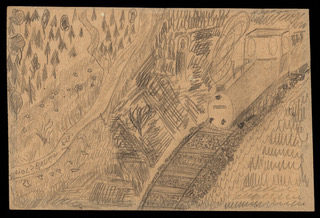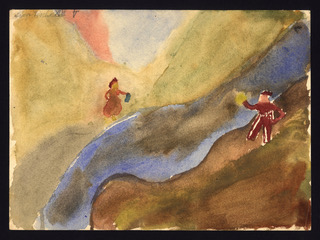Summary | Excerpt | Reading Guide | Reviews | Beyond the Book | Read-Alikes | Genres & Themes | Author Bio

This article relates to The World That We Knew
In Alice Hoffman's novel The World That We Knew, Julien, 14, escapes occupied Paris and finds temporary refuge at a rural chateau-turned-orphanage. He tutors math and participates in art workshops there. The displaced children survive day-to-day, and are encouraged to express themselves with drawing and painting.
An important collection of children's art of the Holocaust survives today thanks to the efforts of Frederika "Friedl" Dicker-Brandeis, an Austrian-born, Bauhaus-trained artist who was interred at Terezín (Theresienstadt) concentration camp near Prague from December 1942 to September 1944.
Terezín was implemented as a "model ghetto" for Jews, run by Jews under Nazi command, detaining many scholars, doctors, artists, musicians and families. That said, it was still a place where people lived in fear of execution or deportation to a worse fate. Statistics reveal that more than 25 percent of the 141,000 people detained there died or were executed during detention. More than 60 percent were transported east to be murdered in the death camps. Soviet troops liberated 16,832 from Terezín on May 8, 1945.
During her two years at Terezín, Friedl taught art to hundreds of children. She hid the children's art work in suitcases; when she was deported to Auschwitz, she left everything in the care of others. Friedl was murdered in Auschwitz in October 1944 but, thanks to her, more than 4,500 pieces of children's art survive, reflecting the human capacity for creativity and resistance.
Today, this collection of art is safeguarded in the permanent collections of the Jewish Museum in Prague. Children's art has been loaned for international exhibitions and has inspired theatre productions; films; and books for young readers, including I Never Saw Another Butterfly and Fireflies in the Dark.



While most of the young artists who drew, painted, and wrote at Terezín did not survive, the world is richer for their art, which endures.
These three images were all created during the drawing classes in the Terezín ghetto between 1943 and 1944 led by the painter and teacher Friedl Dicker-Brandeis. Used by permission of the Jewish Museum in Prague.
Filed under Music and the Arts
![]() This "beyond the book article" relates to The World That We Knew. It originally ran in October 2019 and has been updated for the
September 2020 paperback edition.
Go to magazine.
This "beyond the book article" relates to The World That We Knew. It originally ran in October 2019 and has been updated for the
September 2020 paperback edition.
Go to magazine.
Your guide toexceptional books
BookBrowse seeks out and recommends the best in contemporary fiction and nonfiction—books that not only engage and entertain but also deepen our understanding of ourselves and the world around us.